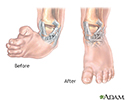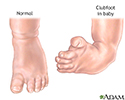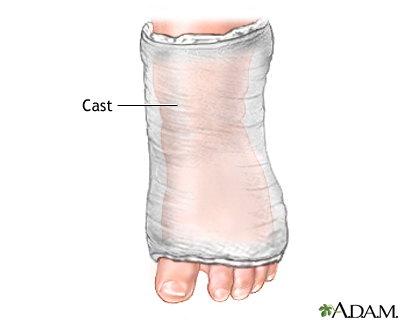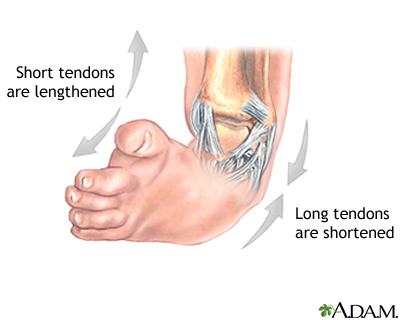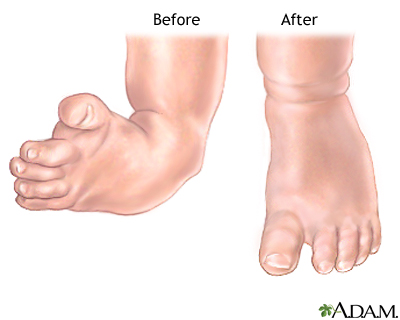Clubfoot
Talipes equinovarus; Talipes
Clubfoot is when the foot turns inward and downward. It is a congenital condition, which means it is present at birth.
Causes
Clubfoot is the most common congenital disorder of the legs. It can range from mild and flexible to severe and rigid.
The cause is not known, but the condition may be passed down through families in some cases. Risk factors include a family history of the disorder and being male.
Symptoms
The physical appearance of the foot may vary. One or both feet may be affected.
The foot turns inward and downward at birth, and is difficult to place in the correct position. The calf muscle and foot may be slightly smaller than normal.
Exams and Tests
The disorder is identified during a physical examination. A foot x-ray may be done.
Treatment
Treatment may involve moving the foot into the correct position and using a cast to keep it there. This is often done by an orthopedic specialist. Treatment should be started as early as possible, ideally, shortly after birth, when it is easiest to reshape the foot.
Gentle stretching and recasting will be done every week to improve the position of the foot. Generally, five to 10 casts are needed. The final cast will stay in place for 3 weeks. After the foot is in the correct position, the child will wear a special brace nearly full time for 3 months. Then, the child will wear the brace at night and during naps for up to 3 years.
Often, the problem is a tightened Achilles tendon, and a simple procedure is needed to release it.
Some severe cases of clubfoot will need surgery if other treatments do not work, or if the problem returns. The child should be monitored by a health care provider until the foot is fully grown.
Surgery
Clubfoot repair is surgery to correct a birth defect of the foot and ankle.

Outlook (Prognosis)
The outcome is usually good with treatment.
Possible Complications
Some defects may not be completely fixed. However, treatment can improve the appearance and function of the foot. Treatment may be less successful if the clubfoot is linked to other birth disorders.
When to Contact a Medical Professional
If your child is being treated for clubfoot, call your health care provider if:
- The toes swell, bleed, or change color under the cast
- The cast appears to be causing significant pain
- The toes disappear into the cast
- The cast slides off
- The foot begins to turn in again after treatment
References
Kelly DM. Congenital anomalies of the lower extremity. In: Canale ST, Beaty JH, eds. Campbell's Operative Orthopaedics . 12th ed. Philadelphia, PA: Elsevier Mosby; 2013:chap 29.
Ricco AI, Richards S, Herring JA. Disorders of the foot. In: Herring JA, ed.
Tachdjian's Pediatric Orthopaedics.
5th ed. Philadelphia, PA: Elsevier Saunders; 2014:chap 23.
-
Club foot deformity - illustration
Clubfoot is the most common congenital disorder of the lower extremity. One or both feet turn downward and inward. Genetic and environmental factors in the development of the fetus are the apparent causes.
Club foot deformity
illustration
-
Club foot repair - series
Presentation
-
Club foot deformity - illustration
Clubfoot is the most common congenital disorder of the lower extremity. One or both feet turn downward and inward. Genetic and environmental factors in the development of the fetus are the apparent causes.
Club foot deformity
illustration
-
Club foot repair - series
Presentation
Review Date: 11/19/2015
Reviewed By: Neil K. Kaneshiro, MD, MHA, Clinical Assistant Professor of Pediatrics, University of Washington School of Medicine, Seattle, WA. Also reviewed by David Zieve, MD, MHA, Isla Ogilvie, PhD, and the A.D.A.M. Editorial team.

